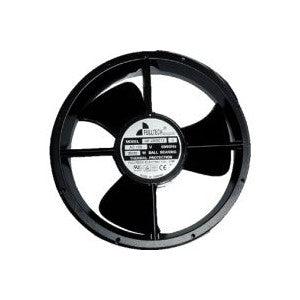Axial Fans are ideally suited for space ventilation or cooling higher wattage lighting allowing you more temperature control over your plants
-
An axial fan is a type of fan that causes gas to flow through it in an axial direction, parallel to the shaft about which the blades rotate. The flow is axial at entry and exit. The fan is designed to produce a pressure difference, and hence force, to cause a flow through the fan
Because of the low-pressure high-volume airflows they create, axial fans are best suited for general purpose applications. For example, they excel at moving air from one place to another, cooling confined spaces such as computers, and cooling larger spaces such as work spaces.
A standard AC model is energy efficient, using no more than 100 watts when on high speed. AC fans can be connected directly to a DC power source, such as solar panels or batteries. Since the end goal in units like vending machines is an even flow of cooling power, an AC fan is the fairly obvious choice.
Axial vs Centrifugal Fans
There are two primary varieties of fan, axial fans and centrifugal fans. Pelonis Technologies, Inc. (PTI), a global leader in fan technology for more than 25 years, manufactures both axial and centrifugal fans.
Clear the Confusion — Axial Vs. Centrifugal
To help clear up that confusion, here is a breakdown of the fan types, their benefits, and their uses.
The design and function of a centrifugal fan is very different from those of an axial fan. Their differences make them each suited for different applications and customers are sometimes unclear as to which fan type will best suit their needs.
Axial Fans
- Date back to the horizontally configured windmills of Europe in the Middle Ages. The first electrically powered fans, introduced in the 1880s, were axial fans.
- Are named for the direction of the airflow they create. Blades rotating around an axis draw air in parallel to that axis and force air out in the same direction.
- Create airflow with a high flow rate, meaning they create a large volume of airflow. However, the airflows they create are of low pressure. They require a low power input for operation.
Centrifugal Fans
The centrifugal fan was invented in 1832 by military engineer Lieutenant General Alexander Sablukov of the Russian Empire’s Imperial Russian Army.
Often called blowers, centrifugal fans vary differently from axial fans. The pressure of an incoming airstream is increased by a fan wheel, a series of blades mounted on a circular hub. Centrifugal fans move air radially — the direction of the outward flowing air is changed, usually by 90°, from the direction of the incoming air.
The airflow created by centrifugal fans is directed through a system of ducts or tubes. This helps create a higher pressure airflow than axial fans. Despite a lower flow rate, centrifugal create a steadier flow. Centrifugal also require a higher power input.
Ships with detachable power cord
Plugs into any 110V/120V outlet


